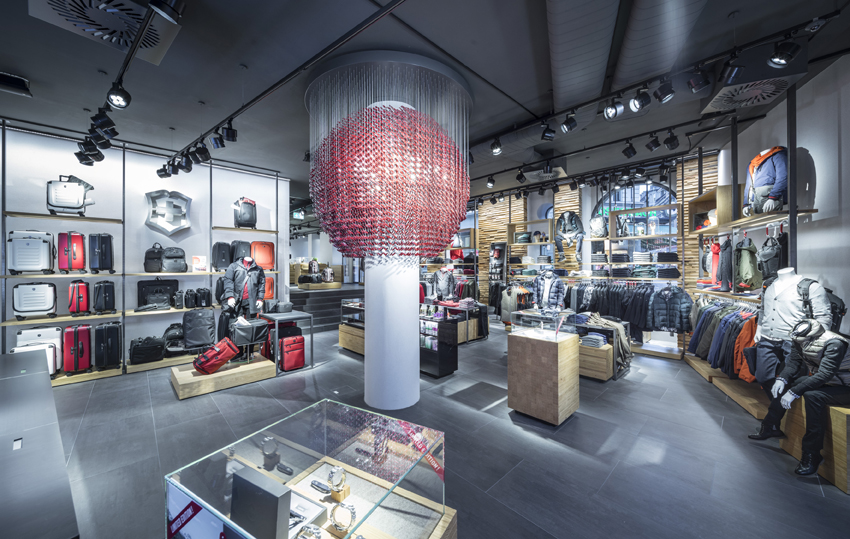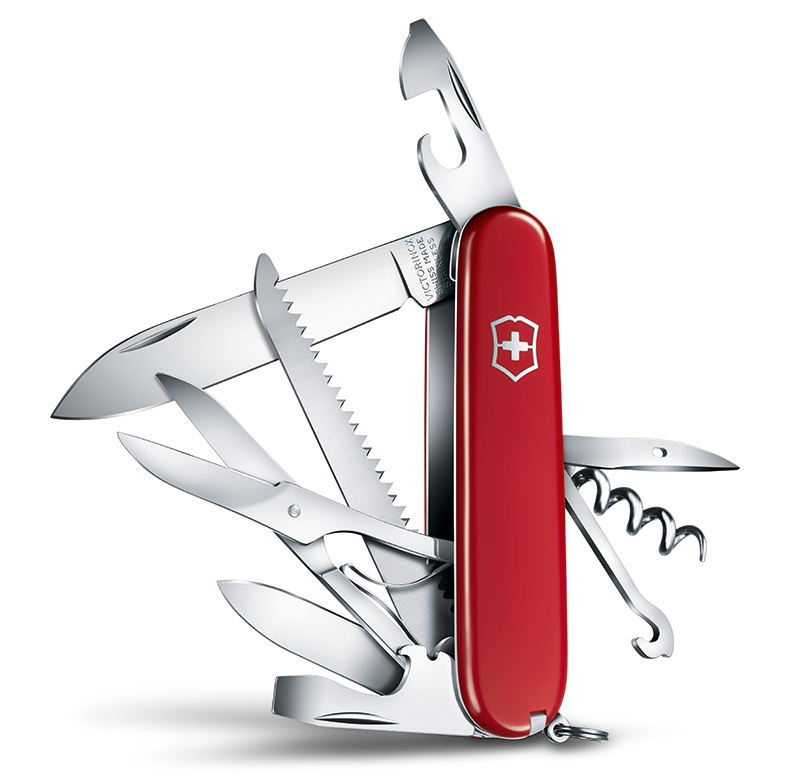
The Victorinox office in Canton of Schwyz, Switzerland.
An Interview with Victorinox's Pierre Salamon on culture, creativity and the famous multipurpose tool.
When both the Boy Scouts of America and the Museum of Modern Art find purpose in the same object it begs a few questions. How exactly does design form meet the Scout motto “Be prepared”? And where does the mutual interest from these very different audiences come from? With the execution of a simple design principle, in an object you’re probably familiar with: the Swiss Army Knife. Form follows function, and tool becomes design object. AIGA executive director Julie Anixter spoke with Pierre Salamon, Vice President, Global People Development at Victorinox, about the famously multipurpose tool as a metaphor for the skills designers need to have today, how trust is the key to building a successful team, and why you can expect epiphanies in unexpected places, like 90 feet under water. That’s saying something, when Victorinox, the maker of the Swiss Army Knife, is based in the Swiss Alps.
Julie Anixter: What was your reaction to the statement by a panelist at the last Fast Company Design Conference that designers need to become more like Swiss Army knives?
Pierre Salamon: I smiled. I think it's smart. My first reaction was to go back to the Swiss Army knife and why we’re making this analogy. A Swiss Army knife goes towards quality, innovation, multifunctionality, and of course a unique design. It's about being able to do different things cleverly. That's the extraordinary power of that tool. No longer do we have one role. We have so many roles in life. So, for me that comparison can be a catalyst for taking in new visions. Designers take in new ideas, new shapes, new form, and new needs, and then turn them into business. From vision to execution.
JA: What kind of company is Victorinox?
PS: It's a family. It's a fourth-generation, family-owned Swiss company anchored in Ibach, a small village in the Canton of Schwyz and the heart of Switzerland. They are the original makers of the Swiss Army knife—and from there, a global icon was born. From a design point of view and from a unique tool point of view, its cross and shield emblem is recognized worldwide. We even see it in the Museum of Modern Art in New York as an icon of design.
At its core, it’s a company that lives family values. The trust that comes to my mind first is then layered with courage and responsibility, and all of these values are transferred to the employees and the leaders. Victorinox is a company that truly trusts and respects its powerful people engine. Humility, openness, creativity, diversity — values that are shared by the people who live there.
JA: What is the conversation about design like at Victorinox?
PS: As far as our thoughts or actions are concerned, we’re all inspired by the values and the heritage of the Swiss Army knife. So, take the Swiss Army knife: its quality, its functionality, its innovation, its design. These are the values that we can transfer into product development, marketing, and sales.
Conversations are always going on around design. It's part of the DNA of who we are and what we are. Swiss Army knife and cutlery, for example, have their own creative team of talented designers who work together to create the knives of the future and the inspiration for future products. That passion exists through all of our products: watches, travel gear, and fragrance.

Interior of the Victorinox store in Zurich.
JA: You're the Head of People Development. Does this change the way you recruit and the kind of people you're looking for?
PS: The talent that we bring into the company has to integrate into this new idea that we are multifunctional, global, and traditional. We need to be broader than what we are. That's why I thrive working here. It's not so much what we are—although that is very important—it's what we can be that matters. What do we want to be? How could we shape this in a different way? In better ways? What does success look like for the future? So those are the questions that are integrated into my role. For people development it's crucial.
When we fall, we pick each other up and we try again, and we try differently.
JA: How do you keep a culture moving forward and the flame of creativity alive?
PS: My role in people development and training is growing our team, and growing our team to be more effective. Coaching and enhancing leadership principles. Organizing workshops around the world. So, that role is to inspire and motivate our leaders and all of our employees to be more satisfied with their work, career, and personally. How do we do that? We don't focus on what we are, we focus on what we can be. In other words, the talent we have can continue to grow in different areas we didn't know we had. The result I see in people's actions or behavior is terrific. Sure we have challenges, and we recover from them, we build on strengths. That's what work is about. It's trying to find out new ways, so when we fall, we pick each other up and we try again, and we try differently.
I love people. It's my source of inspiration. It's not difficult to find. And my flame that keeps on burning is due to nature and the arts. Colors, words, and ideas captured in museums, theater, concerts, or at the movies. Traveling is also a great source of inspiration. Without that, I don't think I’d be able to create. I took on another challenge recently: scuba diving. I like challenging myself at 90 feet below the surface. It’s another environment where we're not so welcome, I guess. When I come back to the surface, it gives me a whole new perspective. It gives me strength. You make some remarkable encounters down there—I can’t tell all the secrets!
Trust is the foundation of our ability to create.
I’d also say family, friends, colleagues, and bosses inspire me. We share a journey and there's no reason why that journey shouldn't be a pleasant one. I love our products and design, and my colleagues and I work hard to keep this business growing with courage and gratitude. Another flame is the trust I see from the value of the company, that is given to various roles, and that creates more trust. Trust is really the foundation of our ability to create. It creates more ability to be heard. If we don't trust one another, it's very hard to work with each other. So, trust is incredibly powerful, because then you're on a winning team. Work doesn't seem like work anymore. I think that's a great philosophy. That doesn't keep me up at night; it gets me up in the morning. Besides, of course, coffee.

The Swiss Army knife.
JA: Is there anything you would have liked me to ask you that I didn't?
PS: What else is there that we can do? Not just to be better, but to be different and more connected to each other and to the world we live in. We didn't talk about, for example, the role Swiss Army knives have in people's lives. They keep you moving. It's not just a tool; it's a friend. It's something that solves problems, brings pleasure, finds solutions… they keep your day moving forward.
I joined a spinning class lately. It's something I wanted to try and do, so, I've become quite good at it. I bought my own spinning shoes. They have a little latch that secures your feet, and one came out. Class was about to begin, and I was in trouble. So, I pulled out my Swiss Army knife, opened the screwdriver, and tightened the latch on my shoe. I was saved right there on the spot. There was that sense of being completely in charge of my mobility. I was able to keep on going. Keep on moving.
So, my wish is for designers is to keep moving. Keep traveling and understanding the world from the business and artistic side. Engage with people. I think designers have a huge role in the future. Be curious. Use open-ended questions, not closed questions. Find out the wishes of people and translate them to a concept and concrete products. Designers have to be adventurers. To me, they're the new heroes of this world. Be bold, listen, encourage, and inspire others. Designers are Motivators-in-Chief. I love working with them. They motivate and inspire me with their courage to become more connected to the world.
